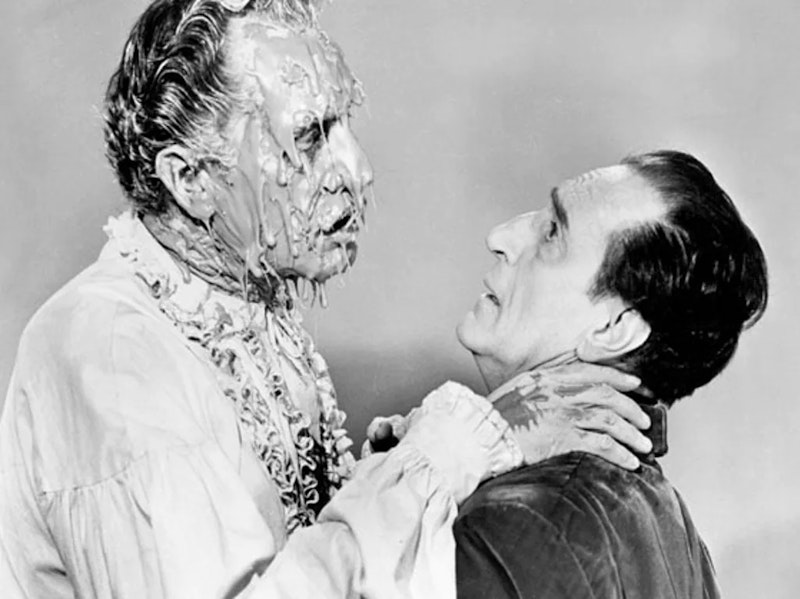After making three movies based on the stories of Edgar Allan Poe in three years, Roger Corman was getting tired of Poe. But AIP, the company behind his films, wanted him to continue with the profitable series. In fact, they wanted him to shoot a second movie to come out in 1962, after the March release of The Premature Burial. Determined to try something new, Corman made an anthology film.
Tales of Terror is a collection of three separate Poe adaptations, all directed by Corman from scripts by Richard Matheson, and all starring Vincent Price. Each was shot in about a week, but each has a separate tone, and other than Price a different cast of actors.
“Morella” is the most similar to Corman’s preceding Poe films. It begins, as those movies did, with a visitor to an isolated old house. The visitor’s Lenora Locke (Maggie Pierce), calling on her depressed father (Price). They’re estranged, because the elder Locke blames his daughter for the death of her mother—who died giving birth to her, and whose body he keeps in the house. But Morella Locke (Leona Gage) may not be as dead as he thinks, and the story moves briskly to a violent conclusion.
“The Black Cat” changes the formula by adding a lot of comedy, and does so with brio. It takes place in a town setting, albeit a town as visually stylized as the isolated mansions we see in Corman’s Poe movies. It’s home to the drunkard Montresor Herringbone (a superb deadpan Peter Lorre), his long-suffering wife Annabel, and their cat (roundly loathed by Montresor). Montresor stumbles back and forth from the bar to his home, while his wife tries to make ends meet. Then Montresor stumbles into a wine-tasting contest with a famous connoisseur, Fortunato Luchresi (Price), and wins. But when Fortunato meets Annabel, sparks fly. Events build, and as the character names suggest, the story ends up fused with “The Cask of Amontillado.”
Finally, “The Facts in the Case of M. Valdemar” gives us Price as the dying Ernest Valdemar, who hires a sinister hypnotist named Carmichael (Basil Rathbone in full villain mode) to ease his pain. But Carmichael’s drawn to Valdemar’s beautiful young wife Helene (Debra Paget), who’s attracted to Valdemar’s doctor, Eliot James (David Frankham). Helene and Dr. James don’t want to act on their attraction while Valdemar’s alive, but then Carmichael’s hypnosis traps Valdemar between life and death, leading to a grisly resolution of the love triangle.
As is typical for Corman’s pictures, the scripts take liberties with the original stories, but end up getting at similar tones. If some of the irony’s missing from “Morella,” and Morella’s character is less vivid, the humor of “The Black Cat” manages to evoke the same kind of macabre smiles that Poe frequently does. The love triangles of “Valdemar” are invented for the film, but the basic situation of hypnosis holding a man between the lands of the living and the dead is the same.
Corman’s movies are often showcases for Vincent Price, and that’s the case here. Price demonstrates his range, obsessed and comic and benevolent by turns. It’s unfortunate that Maggie Pierce in the first story isn’t a particularly strong actress, because later scenes with Lorre and Rathbone are lovely; the comedic chemistry of Price as straight man to the dissolute Lorre justifies the film on its own.
“Morella” and “Valdemar” are slight by comparison, but still worth watching. It’s striking that none of the segments feels like an episode from an anthology TV show—there’s nothing here that evokes The Twilight Zone or Alfred Hitchcock Presents, even though Matheson wrote for both. The acting in Tales is allowed to be central, and Corman’s visual storytelling and camera movement unobtrusively establish a cinematic sense to the film. The budget and shooting schedule aren’t that different from TV, but the end result is clearly a movie and not a small-screen production.
And then there’s the verve Corman brings to the film. There’s a characteristic Robertson Davies called shamanstvo, “enchanter-quality,” which Davies described as sheer storytelling energy. It’s the power some storytellers have of telling a tale that keeps the audience spellbound. The ends of “Morella” and especially “Valdemar” see Corman reaching into his bag of tricks to entertain his viewers, and pulling out cheap effects he uses without shame—and it works because he knows what he’s doing. “Valdemar” builds to its effect shot, and if it’s an artificial image it’s also a purely visual way to end the story and the film.
Corman’s energy carries the stories, and as a result the brevity of the different segments works in their favor. Price can’t build a character the way he did in Corman’s earlier films, but balancing that is the range of incident that unspools within a half-hour of screen time. And in some way the three stories knit together, each doing something a little different, so that it all feels unified.
You come to Roger Corman’s movies looking to be entertained, and he aims to please. This movie’s not concerned with profound explorations of what’s most horrific in life. It’s interested in cheap thrills and Tales of Terror pulls off the trick.

